ATFC Ltd: ERP Deployment Proposal for Strategic Information Systems
VerifiedAdded on 2023/06/11
|19
|4499
|209
Report
AI Summary
This report presents an ERP deployment proposal for Air Travels Flight Centre (ATFC) Ltd, addressing the company's need to streamline operations across its branches. It begins by outlining the challenges faced by ATFC due to unintegrated business processes and the complications arising from transferring booking information between centers. The report then delves into the importance of business process re-engineering (BPR) and its role in preparing the organization for a successful ERP implementation. It identifies business and system requirements, proposes SAP ERP as the optimal solution, and discusses the benefits of ERP adoption. Furthermore, the report provides guidance on software and vendor selection, highlights potential challenges and risks associated with ERP implementation, and suggests mitigation strategies. The conclusion recommends that ATFC adopt the SAP ERP solution to enhance business operations, emphasizing the importance of user training and effective planning for maximizing ERP efficiency. Desklib offers a variety of resources, including past papers and solved assignments, to support students in understanding and implementing ERP solutions.
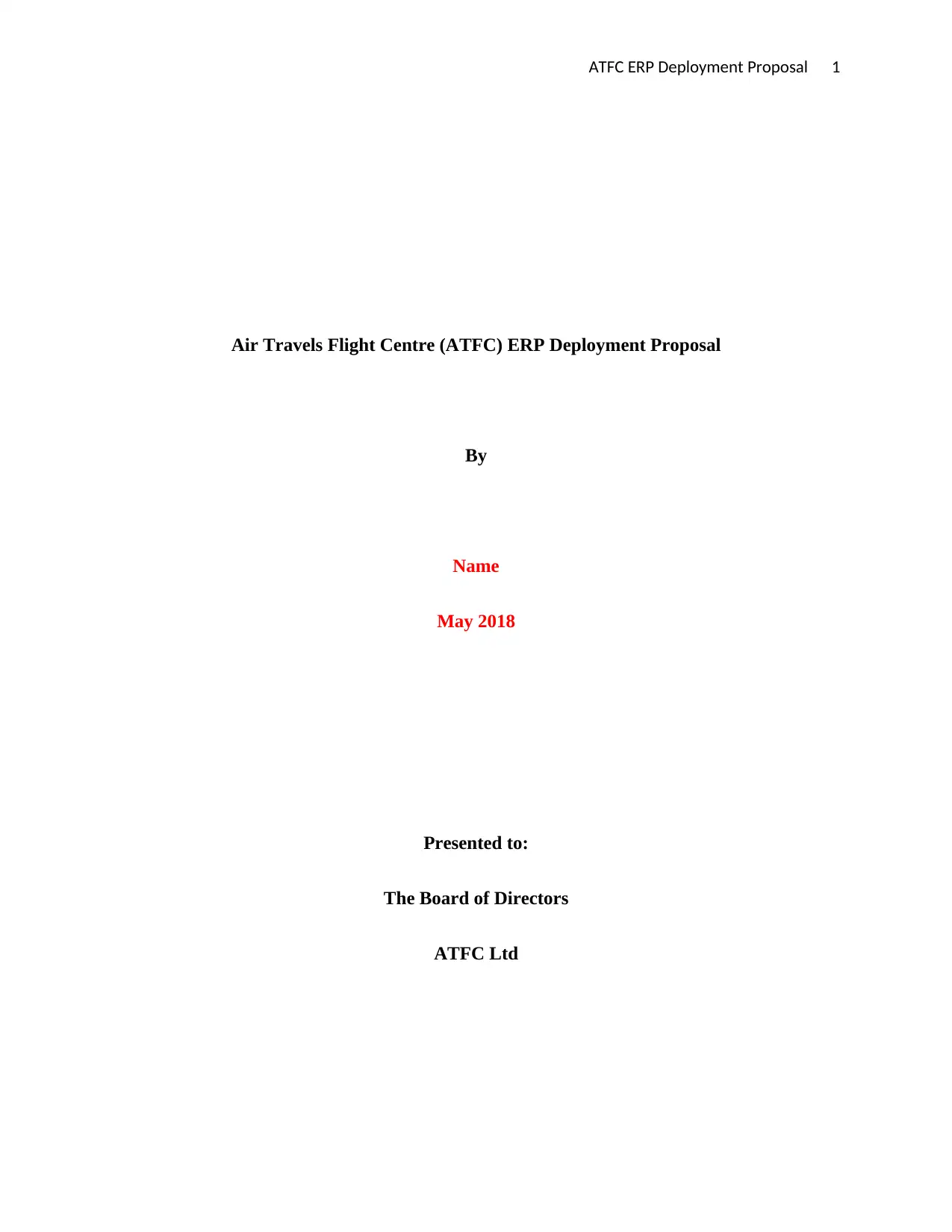
ATFC ERP Deployment Proposal 1
Air Travels Flight Centre (ATFC) ERP Deployment Proposal
By
Name
May 2018
Presented to:
The Board of Directors
ATFC Ltd
Air Travels Flight Centre (ATFC) ERP Deployment Proposal
By
Name
May 2018
Presented to:
The Board of Directors
ATFC Ltd
Paraphrase This Document
Need a fresh take? Get an instant paraphrase of this document with our AI Paraphraser
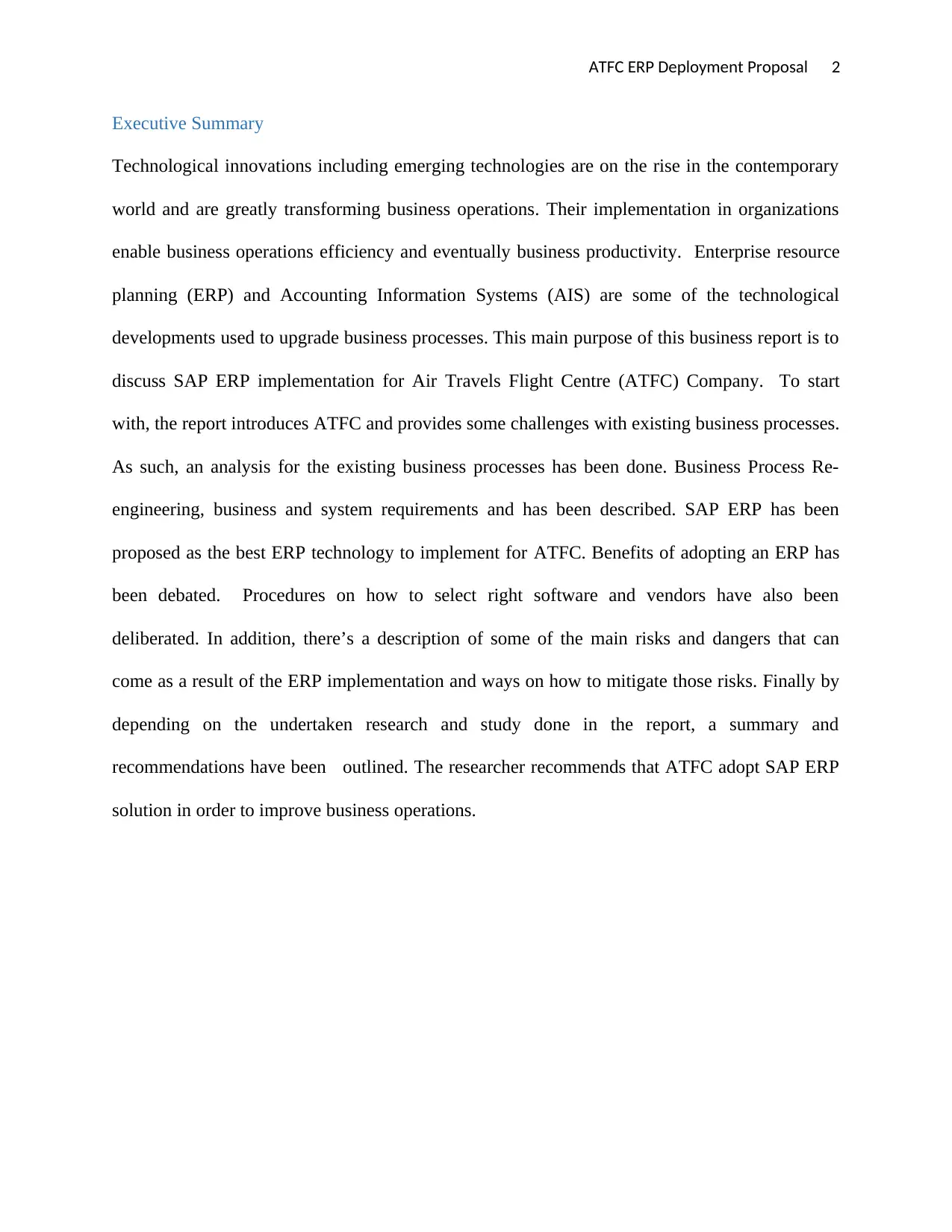
ATFC ERP Deployment Proposal 2
Executive Summary
Technological innovations including emerging technologies are on the rise in the contemporary
world and are greatly transforming business operations. Their implementation in organizations
enable business operations efficiency and eventually business productivity. Enterprise resource
planning (ERP) and Accounting Information Systems (AIS) are some of the technological
developments used to upgrade business processes. This main purpose of this business report is to
discuss SAP ERP implementation for Air Travels Flight Centre (ATFC) Company. To start
with, the report introduces ATFC and provides some challenges with existing business processes.
As such, an analysis for the existing business processes has been done. Business Process Re-
engineering, business and system requirements and has been described. SAP ERP has been
proposed as the best ERP technology to implement for ATFC. Benefits of adopting an ERP has
been debated. Procedures on how to select right software and vendors have also been
deliberated. In addition, there’s a description of some of the main risks and dangers that can
come as a result of the ERP implementation and ways on how to mitigate those risks. Finally by
depending on the undertaken research and study done in the report, a summary and
recommendations have been outlined. The researcher recommends that ATFC adopt SAP ERP
solution in order to improve business operations.
Executive Summary
Technological innovations including emerging technologies are on the rise in the contemporary
world and are greatly transforming business operations. Their implementation in organizations
enable business operations efficiency and eventually business productivity. Enterprise resource
planning (ERP) and Accounting Information Systems (AIS) are some of the technological
developments used to upgrade business processes. This main purpose of this business report is to
discuss SAP ERP implementation for Air Travels Flight Centre (ATFC) Company. To start
with, the report introduces ATFC and provides some challenges with existing business processes.
As such, an analysis for the existing business processes has been done. Business Process Re-
engineering, business and system requirements and has been described. SAP ERP has been
proposed as the best ERP technology to implement for ATFC. Benefits of adopting an ERP has
been debated. Procedures on how to select right software and vendors have also been
deliberated. In addition, there’s a description of some of the main risks and dangers that can
come as a result of the ERP implementation and ways on how to mitigate those risks. Finally by
depending on the undertaken research and study done in the report, a summary and
recommendations have been outlined. The researcher recommends that ATFC adopt SAP ERP
solution in order to improve business operations.
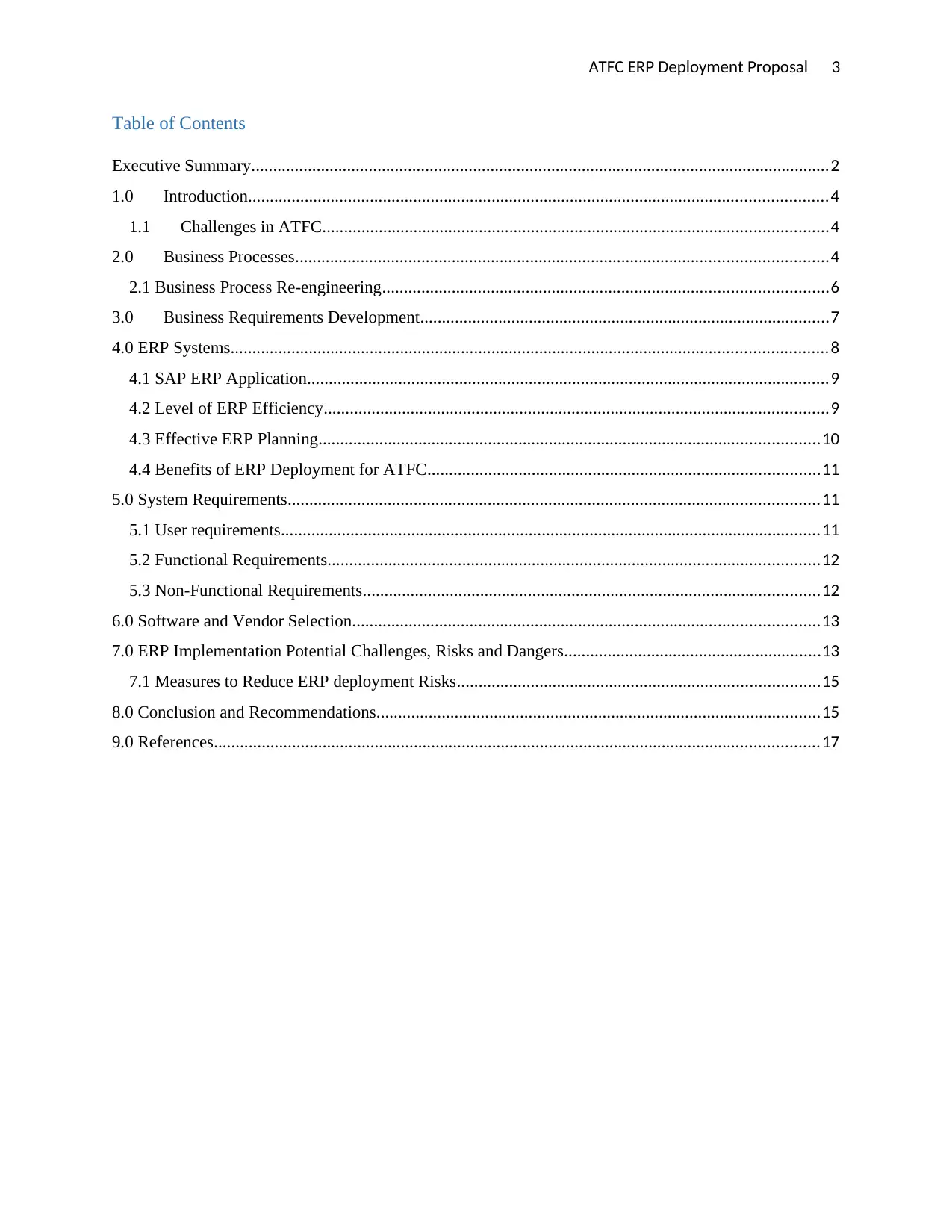
ATFC ERP Deployment Proposal 3
Table of Contents
Executive Summary.....................................................................................................................................2
1.0 Introduction.....................................................................................................................................4
1.1 Challenges in ATFC....................................................................................................................4
2.0 Business Processes..........................................................................................................................4
2.1 Business Process Re-engineering......................................................................................................6
3.0 Business Requirements Development..............................................................................................7
4.0 ERP Systems.........................................................................................................................................8
4.1 SAP ERP Application........................................................................................................................9
4.2 Level of ERP Efficiency....................................................................................................................9
4.3 Effective ERP Planning...................................................................................................................10
4.4 Benefits of ERP Deployment for ATFC..........................................................................................11
5.0 System Requirements..........................................................................................................................11
5.1 User requirements............................................................................................................................11
5.2 Functional Requirements.................................................................................................................12
5.3 Non-Functional Requirements.........................................................................................................12
6.0 Software and Vendor Selection...........................................................................................................13
7.0 ERP Implementation Potential Challenges, Risks and Dangers...........................................................13
7.1 Measures to Reduce ERP deployment Risks...................................................................................15
8.0 Conclusion and Recommendations......................................................................................................15
9.0 References...........................................................................................................................................17
Table of Contents
Executive Summary.....................................................................................................................................2
1.0 Introduction.....................................................................................................................................4
1.1 Challenges in ATFC....................................................................................................................4
2.0 Business Processes..........................................................................................................................4
2.1 Business Process Re-engineering......................................................................................................6
3.0 Business Requirements Development..............................................................................................7
4.0 ERP Systems.........................................................................................................................................8
4.1 SAP ERP Application........................................................................................................................9
4.2 Level of ERP Efficiency....................................................................................................................9
4.3 Effective ERP Planning...................................................................................................................10
4.4 Benefits of ERP Deployment for ATFC..........................................................................................11
5.0 System Requirements..........................................................................................................................11
5.1 User requirements............................................................................................................................11
5.2 Functional Requirements.................................................................................................................12
5.3 Non-Functional Requirements.........................................................................................................12
6.0 Software and Vendor Selection...........................................................................................................13
7.0 ERP Implementation Potential Challenges, Risks and Dangers...........................................................13
7.1 Measures to Reduce ERP deployment Risks...................................................................................15
8.0 Conclusion and Recommendations......................................................................................................15
9.0 References...........................................................................................................................................17
⊘ This is a preview!⊘
Do you want full access?
Subscribe today to unlock all pages.

Trusted by 1+ million students worldwide
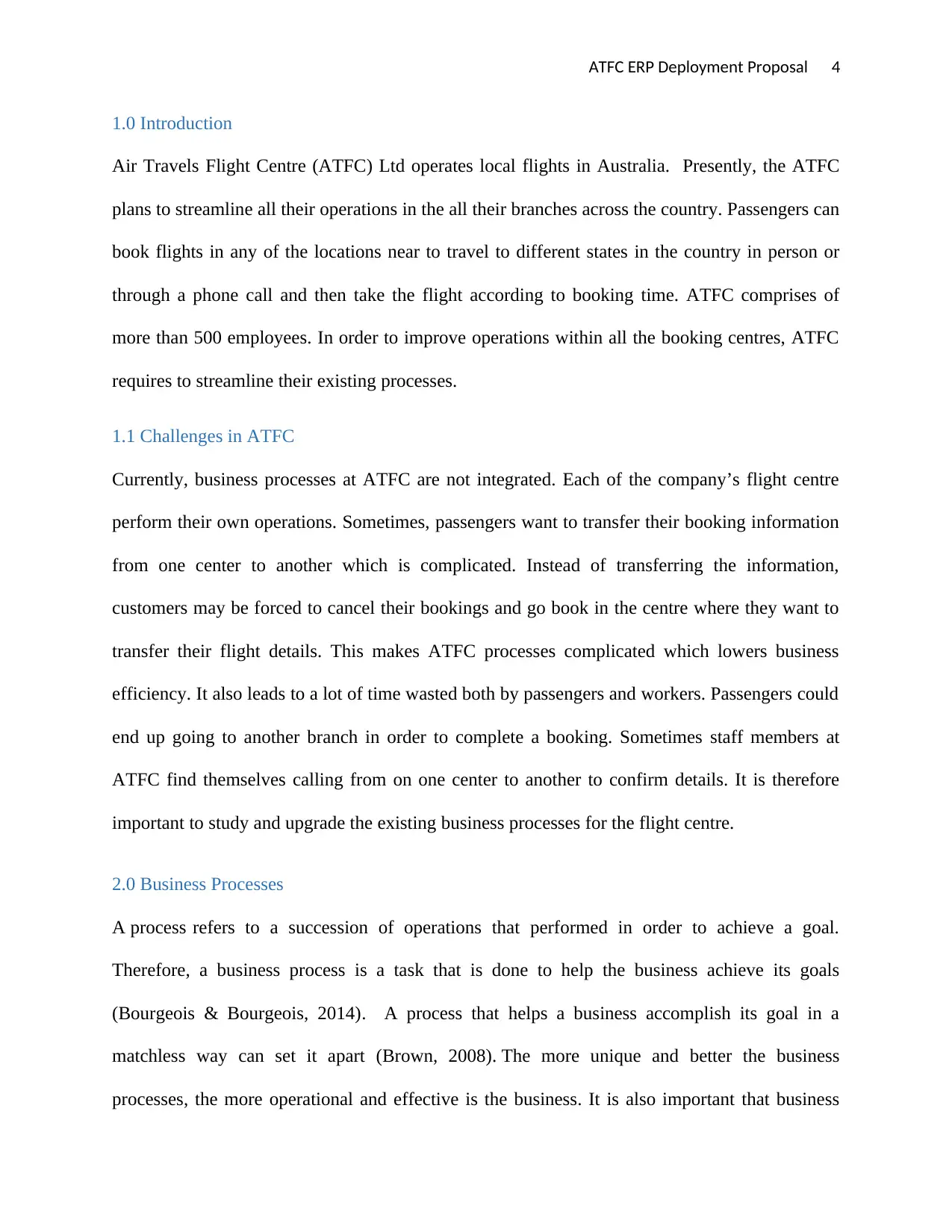
ATFC ERP Deployment Proposal 4
1.0 Introduction
Air Travels Flight Centre (ATFC) Ltd operates local flights in Australia. Presently, the ATFC
plans to streamline all their operations in the all their branches across the country. Passengers can
book flights in any of the locations near to travel to different states in the country in person or
through a phone call and then take the flight according to booking time. ATFC comprises of
more than 500 employees. In order to improve operations within all the booking centres, ATFC
requires to streamline their existing processes.
1.1 Challenges in ATFC
Currently, business processes at ATFC are not integrated. Each of the company’s flight centre
perform their own operations. Sometimes, passengers want to transfer their booking information
from one center to another which is complicated. Instead of transferring the information,
customers may be forced to cancel their bookings and go book in the centre where they want to
transfer their flight details. This makes ATFC processes complicated which lowers business
efficiency. It also leads to a lot of time wasted both by passengers and workers. Passengers could
end up going to another branch in order to complete a booking. Sometimes staff members at
ATFC find themselves calling from on one center to another to confirm details. It is therefore
important to study and upgrade the existing business processes for the flight centre.
2.0 Business Processes
A process refers to a succession of operations that performed in order to achieve a goal.
Therefore, a business process is a task that is done to help the business achieve its goals
(Bourgeois & Bourgeois, 2014). A process that helps a business accomplish its goal in a
matchless way can set it apart (Brown, 2008). The more unique and better the business
processes, the more operational and effective is the business. It is also important that business
1.0 Introduction
Air Travels Flight Centre (ATFC) Ltd operates local flights in Australia. Presently, the ATFC
plans to streamline all their operations in the all their branches across the country. Passengers can
book flights in any of the locations near to travel to different states in the country in person or
through a phone call and then take the flight according to booking time. ATFC comprises of
more than 500 employees. In order to improve operations within all the booking centres, ATFC
requires to streamline their existing processes.
1.1 Challenges in ATFC
Currently, business processes at ATFC are not integrated. Each of the company’s flight centre
perform their own operations. Sometimes, passengers want to transfer their booking information
from one center to another which is complicated. Instead of transferring the information,
customers may be forced to cancel their bookings and go book in the centre where they want to
transfer their flight details. This makes ATFC processes complicated which lowers business
efficiency. It also leads to a lot of time wasted both by passengers and workers. Passengers could
end up going to another branch in order to complete a booking. Sometimes staff members at
ATFC find themselves calling from on one center to another to confirm details. It is therefore
important to study and upgrade the existing business processes for the flight centre.
2.0 Business Processes
A process refers to a succession of operations that performed in order to achieve a goal.
Therefore, a business process is a task that is done to help the business achieve its goals
(Bourgeois & Bourgeois, 2014). A process that helps a business accomplish its goal in a
matchless way can set it apart (Brown, 2008). The more unique and better the business
processes, the more operational and effective is the business. It is also important that business
Paraphrase This Document
Need a fresh take? Get an instant paraphrase of this document with our AI Paraphraser
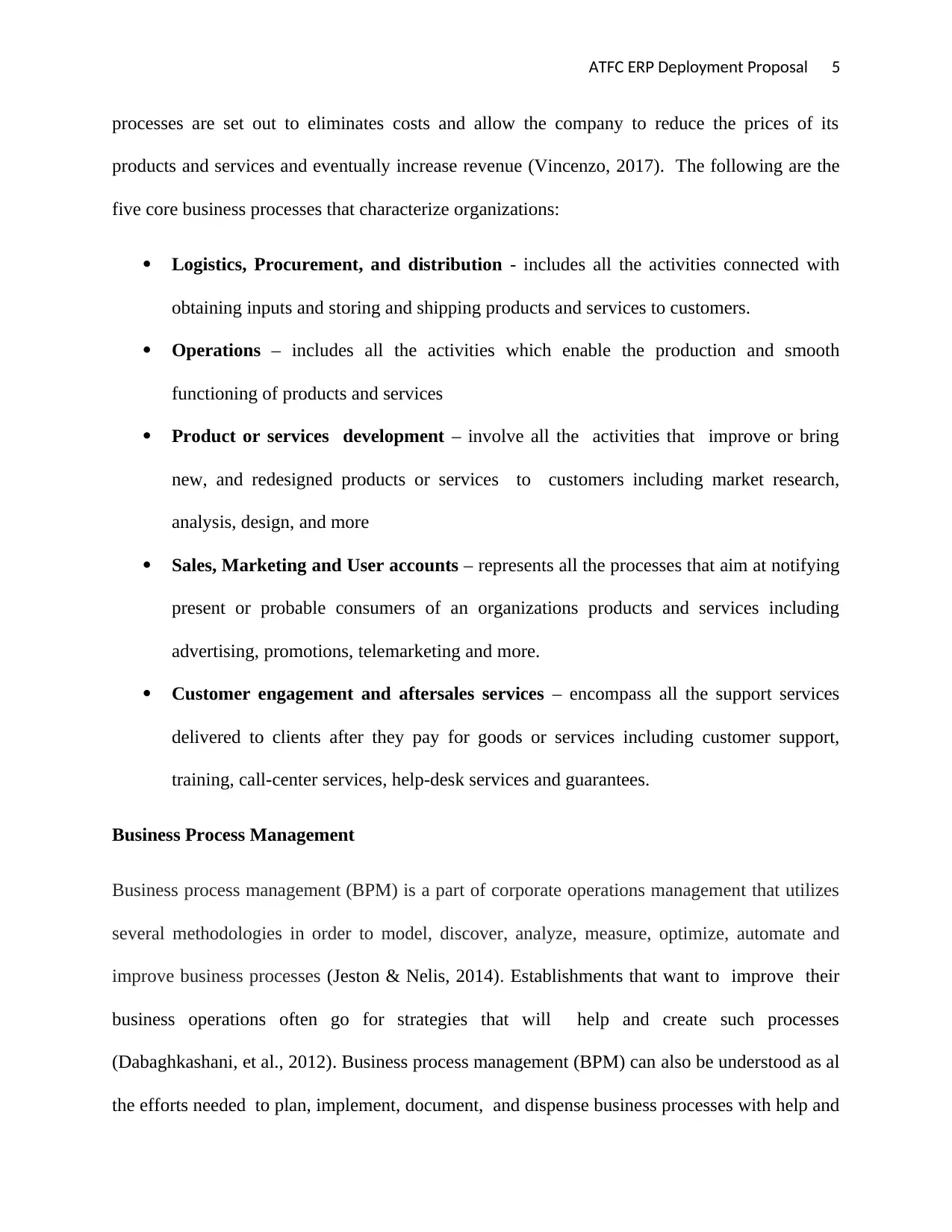
ATFC ERP Deployment Proposal 5
processes are set out to eliminates costs and allow the company to reduce the prices of its
products and services and eventually increase revenue (Vincenzo, 2017). The following are the
five core business processes that characterize organizations:
Logistics, Procurement, and distribution - includes all the activities connected with
obtaining inputs and storing and shipping products and services to customers.
Operations – includes all the activities which enable the production and smooth
functioning of products and services
Product or services development – involve all the activities that improve or bring
new, and redesigned products or services to customers including market research,
analysis, design, and more
Sales, Marketing and User accounts – represents all the processes that aim at notifying
present or probable consumers of an organizations products and services including
advertising, promotions, telemarketing and more.
Customer engagement and aftersales services – encompass all the support services
delivered to clients after they pay for goods or services including customer support,
training, call-center services, help-desk services and guarantees.
Business Process Management
Business process management (BPM) is a part of corporate operations management that utilizes
several methodologies in order to model, discover, analyze, measure, optimize, automate and
improve business processes (Jeston & Nelis, 2014). Establishments that want to improve their
business operations often go for strategies that will help and create such processes
(Dabaghkashani, et al., 2012). Business process management (BPM) can also be understood as al
the efforts needed to plan, implement, document, and dispense business processes with help and
processes are set out to eliminates costs and allow the company to reduce the prices of its
products and services and eventually increase revenue (Vincenzo, 2017). The following are the
five core business processes that characterize organizations:
Logistics, Procurement, and distribution - includes all the activities connected with
obtaining inputs and storing and shipping products and services to customers.
Operations – includes all the activities which enable the production and smooth
functioning of products and services
Product or services development – involve all the activities that improve or bring
new, and redesigned products or services to customers including market research,
analysis, design, and more
Sales, Marketing and User accounts – represents all the processes that aim at notifying
present or probable consumers of an organizations products and services including
advertising, promotions, telemarketing and more.
Customer engagement and aftersales services – encompass all the support services
delivered to clients after they pay for goods or services including customer support,
training, call-center services, help-desk services and guarantees.
Business Process Management
Business process management (BPM) is a part of corporate operations management that utilizes
several methodologies in order to model, discover, analyze, measure, optimize, automate and
improve business processes (Jeston & Nelis, 2014). Establishments that want to improve their
business operations often go for strategies that will help and create such processes
(Dabaghkashani, et al., 2012). Business process management (BPM) can also be understood as al
the efforts needed to plan, implement, document, and dispense business processes with help and
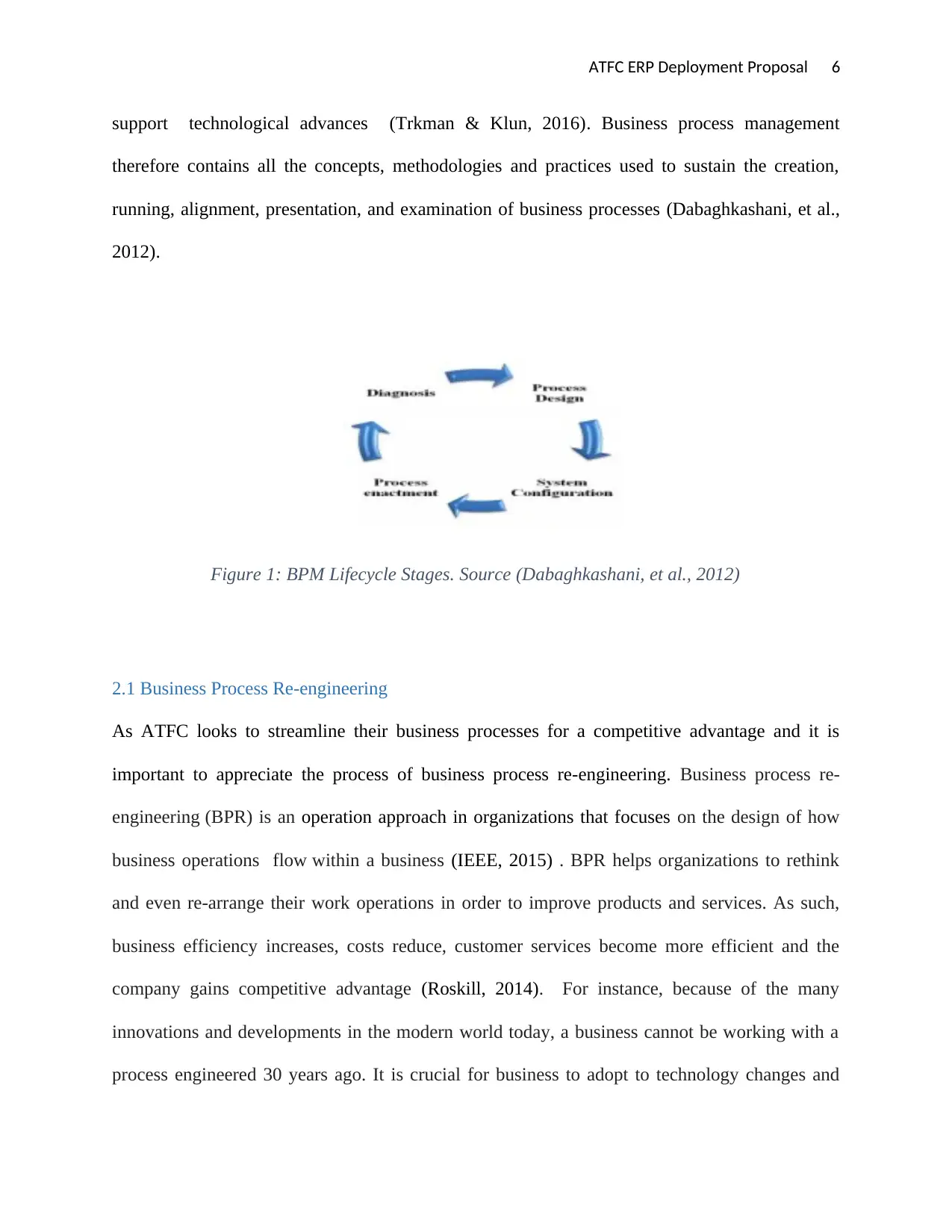
ATFC ERP Deployment Proposal 6
support technological advances (Trkman & Klun, 2016). Business process management
therefore contains all the concepts, methodologies and practices used to sustain the creation,
running, alignment, presentation, and examination of business processes (Dabaghkashani, et al.,
2012).
Figure 1: BPM Lifecycle Stages. Source (Dabaghkashani, et al., 2012)
2.1 Business Process Re-engineering
As ATFC looks to streamline their business processes for a competitive advantage and it is
important to appreciate the process of business process re-engineering. Business process re-
engineering (BPR) is an operation approach in organizations that focuses on the design of how
business operations flow within a business (IEEE, 2015) . BPR helps organizations to rethink
and even re-arrange their work operations in order to improve products and services. As such,
business efficiency increases, costs reduce, customer services become more efficient and the
company gains competitive advantage (Roskill, 2014). For instance, because of the many
innovations and developments in the modern world today, a business cannot be working with a
process engineered 30 years ago. It is crucial for business to adopt to technology changes and
support technological advances (Trkman & Klun, 2016). Business process management
therefore contains all the concepts, methodologies and practices used to sustain the creation,
running, alignment, presentation, and examination of business processes (Dabaghkashani, et al.,
2012).
Figure 1: BPM Lifecycle Stages. Source (Dabaghkashani, et al., 2012)
2.1 Business Process Re-engineering
As ATFC looks to streamline their business processes for a competitive advantage and it is
important to appreciate the process of business process re-engineering. Business process re-
engineering (BPR) is an operation approach in organizations that focuses on the design of how
business operations flow within a business (IEEE, 2015) . BPR helps organizations to rethink
and even re-arrange their work operations in order to improve products and services. As such,
business efficiency increases, costs reduce, customer services become more efficient and the
company gains competitive advantage (Roskill, 2014). For instance, because of the many
innovations and developments in the modern world today, a business cannot be working with a
process engineered 30 years ago. It is crucial for business to adopt to technology changes and
⊘ This is a preview!⊘
Do you want full access?
Subscribe today to unlock all pages.

Trusted by 1+ million students worldwide
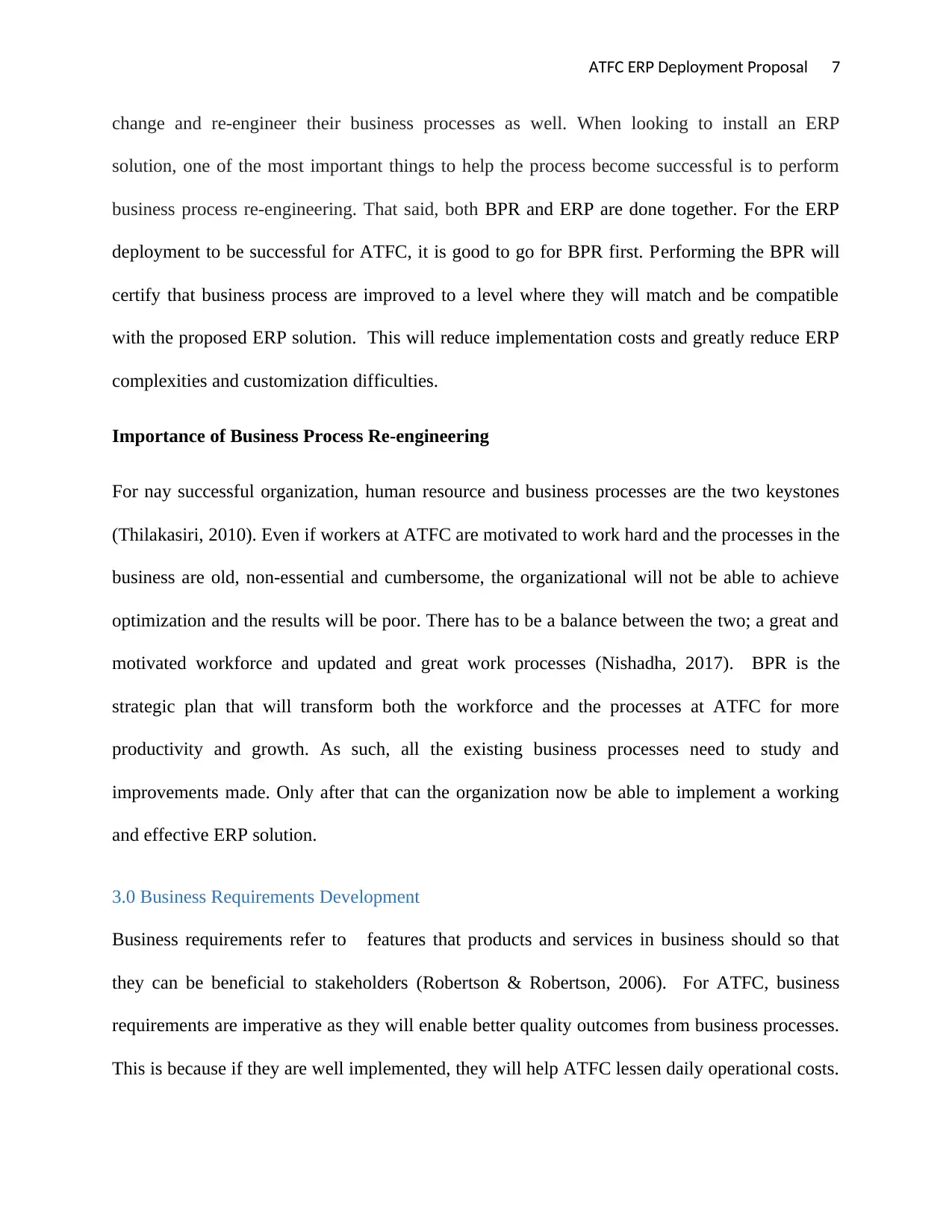
ATFC ERP Deployment Proposal 7
change and re-engineer their business processes as well. When looking to install an ERP
solution, one of the most important things to help the process become successful is to perform
business process re-engineering. That said, both BPR and ERP are done together. For the ERP
deployment to be successful for ATFC, it is good to go for BPR first. Performing the BPR will
certify that business process are improved to a level where they will match and be compatible
with the proposed ERP solution. This will reduce implementation costs and greatly reduce ERP
complexities and customization difficulties.
Importance of Business Process Re-engineering
For nay successful organization, human resource and business processes are the two keystones
(Thilakasiri, 2010). Even if workers at ATFC are motivated to work hard and the processes in the
business are old, non-essential and cumbersome, the organizational will not be able to achieve
optimization and the results will be poor. There has to be a balance between the two; a great and
motivated workforce and updated and great work processes (Nishadha, 2017). BPR is the
strategic plan that will transform both the workforce and the processes at ATFC for more
productivity and growth. As such, all the existing business processes need to study and
improvements made. Only after that can the organization now be able to implement a working
and effective ERP solution.
3.0 Business Requirements Development
Business requirements refer to features that products and services in business should so that
they can be beneficial to stakeholders (Robertson & Robertson, 2006). For ATFC, business
requirements are imperative as they will enable better quality outcomes from business processes.
This is because if they are well implemented, they will help ATFC lessen daily operational costs.
change and re-engineer their business processes as well. When looking to install an ERP
solution, one of the most important things to help the process become successful is to perform
business process re-engineering. That said, both BPR and ERP are done together. For the ERP
deployment to be successful for ATFC, it is good to go for BPR first. Performing the BPR will
certify that business process are improved to a level where they will match and be compatible
with the proposed ERP solution. This will reduce implementation costs and greatly reduce ERP
complexities and customization difficulties.
Importance of Business Process Re-engineering
For nay successful organization, human resource and business processes are the two keystones
(Thilakasiri, 2010). Even if workers at ATFC are motivated to work hard and the processes in the
business are old, non-essential and cumbersome, the organizational will not be able to achieve
optimization and the results will be poor. There has to be a balance between the two; a great and
motivated workforce and updated and great work processes (Nishadha, 2017). BPR is the
strategic plan that will transform both the workforce and the processes at ATFC for more
productivity and growth. As such, all the existing business processes need to study and
improvements made. Only after that can the organization now be able to implement a working
and effective ERP solution.
3.0 Business Requirements Development
Business requirements refer to features that products and services in business should so that
they can be beneficial to stakeholders (Robertson & Robertson, 2006). For ATFC, business
requirements are imperative as they will enable better quality outcomes from business processes.
This is because if they are well implemented, they will help ATFC lessen daily operational costs.
Paraphrase This Document
Need a fresh take? Get an instant paraphrase of this document with our AI Paraphraser
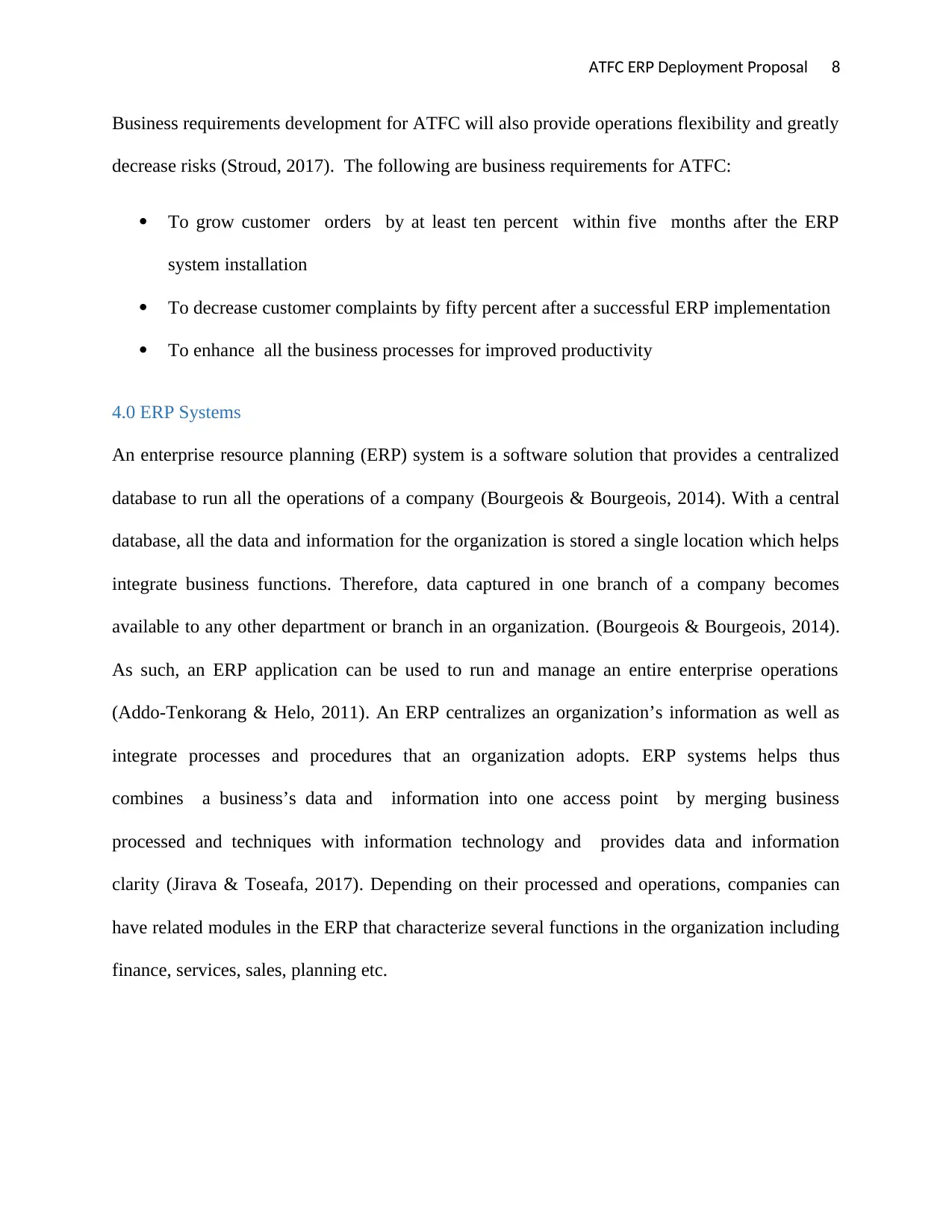
ATFC ERP Deployment Proposal 8
Business requirements development for ATFC will also provide operations flexibility and greatly
decrease risks (Stroud, 2017). The following are business requirements for ATFC:
To grow customer orders by at least ten percent within five months after the ERP
system installation
To decrease customer complaints by fifty percent after a successful ERP implementation
To enhance all the business processes for improved productivity
4.0 ERP Systems
An enterprise resource planning (ERP) system is a software solution that provides a centralized
database to run all the operations of a company (Bourgeois & Bourgeois, 2014). With a central
database, all the data and information for the organization is stored a single location which helps
integrate business functions. Therefore, data captured in one branch of a company becomes
available to any other department or branch in an organization. (Bourgeois & Bourgeois, 2014).
As such, an ERP application can be used to run and manage an entire enterprise operations
(Addo-Tenkorang & Helo, 2011). An ERP centralizes an organization’s information as well as
integrate processes and procedures that an organization adopts. ERP systems helps thus
combines a business’s data and information into one access point by merging business
processed and techniques with information technology and provides data and information
clarity (Jirava & Toseafa, 2017). Depending on their processed and operations, companies can
have related modules in the ERP that characterize several functions in the organization including
finance, services, sales, planning etc.
Business requirements development for ATFC will also provide operations flexibility and greatly
decrease risks (Stroud, 2017). The following are business requirements for ATFC:
To grow customer orders by at least ten percent within five months after the ERP
system installation
To decrease customer complaints by fifty percent after a successful ERP implementation
To enhance all the business processes for improved productivity
4.0 ERP Systems
An enterprise resource planning (ERP) system is a software solution that provides a centralized
database to run all the operations of a company (Bourgeois & Bourgeois, 2014). With a central
database, all the data and information for the organization is stored a single location which helps
integrate business functions. Therefore, data captured in one branch of a company becomes
available to any other department or branch in an organization. (Bourgeois & Bourgeois, 2014).
As such, an ERP application can be used to run and manage an entire enterprise operations
(Addo-Tenkorang & Helo, 2011). An ERP centralizes an organization’s information as well as
integrate processes and procedures that an organization adopts. ERP systems helps thus
combines a business’s data and information into one access point by merging business
processed and techniques with information technology and provides data and information
clarity (Jirava & Toseafa, 2017). Depending on their processed and operations, companies can
have related modules in the ERP that characterize several functions in the organization including
finance, services, sales, planning etc.
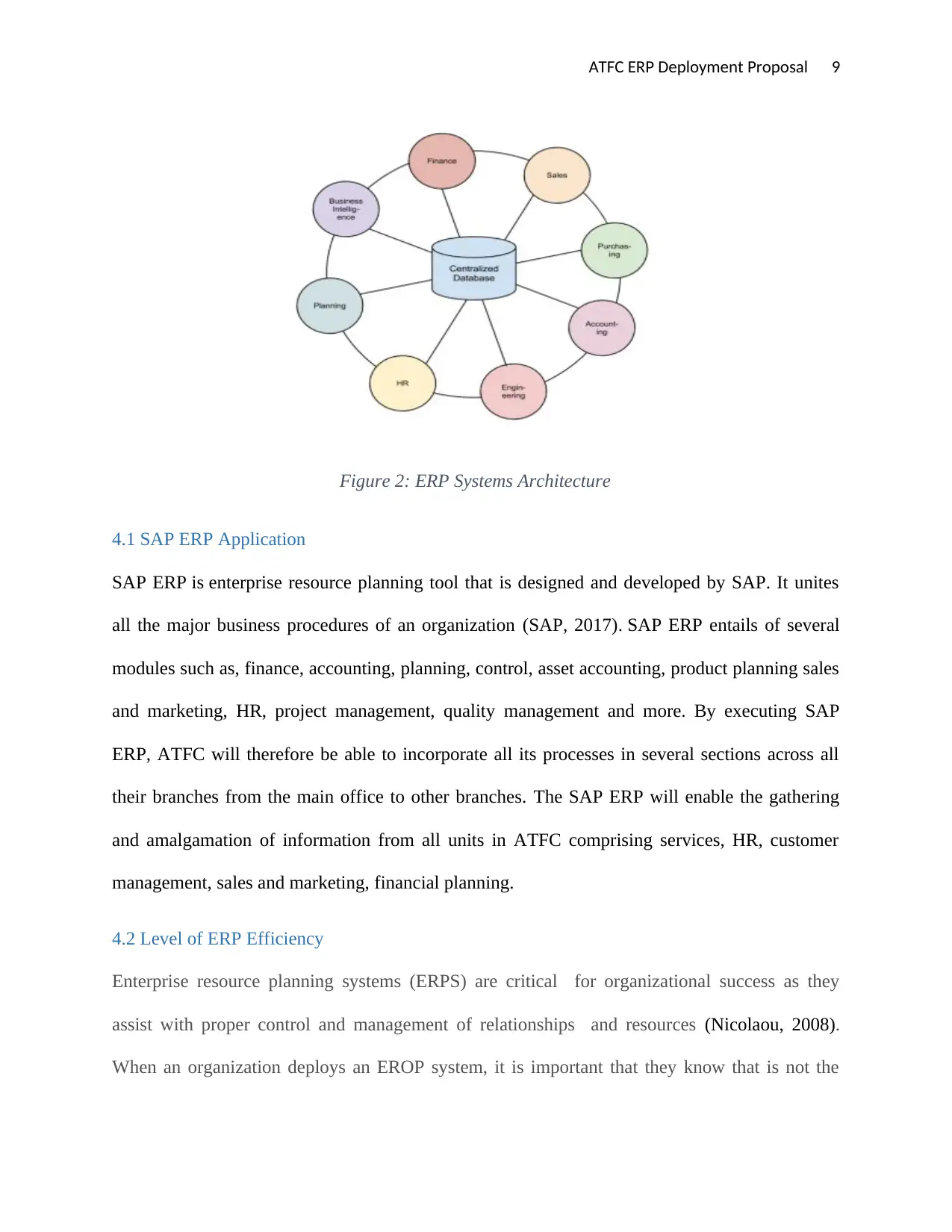
ATFC ERP Deployment Proposal 9
Figure 2: ERP Systems Architecture
4.1 SAP ERP Application
SAP ERP is enterprise resource planning tool that is designed and developed by SAP. It unites
all the major business procedures of an organization (SAP, 2017). SAP ERP entails of several
modules such as, finance, accounting, planning, control, asset accounting, product planning sales
and marketing, HR, project management, quality management and more. By executing SAP
ERP, ATFC will therefore be able to incorporate all its processes in several sections across all
their branches from the main office to other branches. The SAP ERP will enable the gathering
and amalgamation of information from all units in ATFC comprising services, HR, customer
management, sales and marketing, financial planning.
4.2 Level of ERP Efficiency
Enterprise resource planning systems (ERPS) are critical for organizational success as they
assist with proper control and management of relationships and resources (Nicolaou, 2008).
When an organization deploys an EROP system, it is important that they know that is not the
Figure 2: ERP Systems Architecture
4.1 SAP ERP Application
SAP ERP is enterprise resource planning tool that is designed and developed by SAP. It unites
all the major business procedures of an organization (SAP, 2017). SAP ERP entails of several
modules such as, finance, accounting, planning, control, asset accounting, product planning sales
and marketing, HR, project management, quality management and more. By executing SAP
ERP, ATFC will therefore be able to incorporate all its processes in several sections across all
their branches from the main office to other branches. The SAP ERP will enable the gathering
and amalgamation of information from all units in ATFC comprising services, HR, customer
management, sales and marketing, financial planning.
4.2 Level of ERP Efficiency
Enterprise resource planning systems (ERPS) are critical for organizational success as they
assist with proper control and management of relationships and resources (Nicolaou, 2008).
When an organization deploys an EROP system, it is important that they know that is not the
⊘ This is a preview!⊘
Do you want full access?
Subscribe today to unlock all pages.

Trusted by 1+ million students worldwide
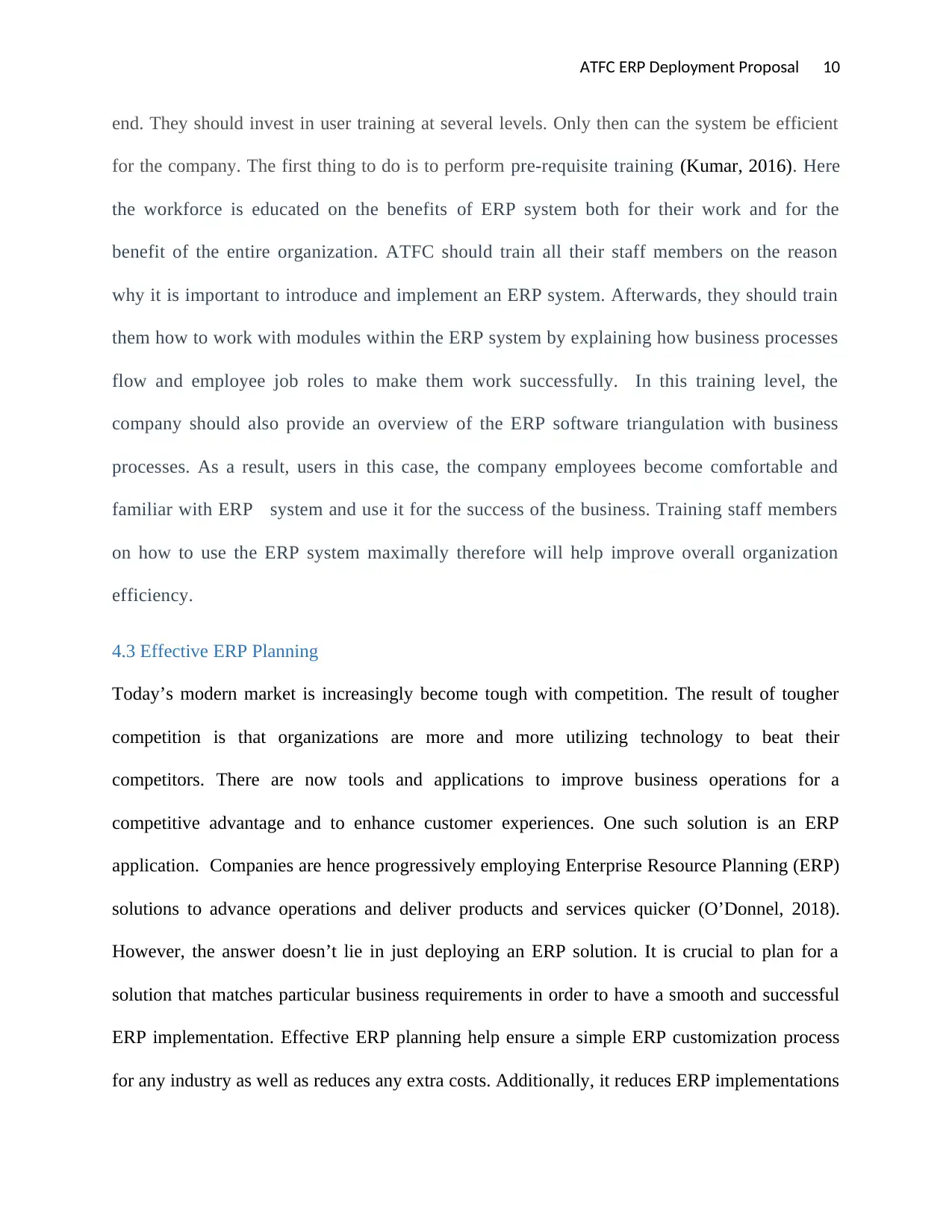
ATFC ERP Deployment Proposal 10
end. They should invest in user training at several levels. Only then can the system be efficient
for the company. The first thing to do is to perform pre-requisite training (Kumar, 2016). Here
the workforce is educated on the benefits of ERP system both for their work and for the
benefit of the entire organization. ATFC should train all their staff members on the reason
why it is important to introduce and implement an ERP system. Afterwards, they should train
them how to work with modules within the ERP system by explaining how business processes
flow and employee job roles to make them work successfully. In this training level, the
company should also provide an overview of the ERP software triangulation with business
processes. As a result, users in this case, the company employees become comfortable and
familiar with ERP system and use it for the success of the business. Training staff members
on how to use the ERP system maximally therefore will help improve overall organization
efficiency.
4.3 Effective ERP Planning
Today’s modern market is increasingly become tough with competition. The result of tougher
competition is that organizations are more and more utilizing technology to beat their
competitors. There are now tools and applications to improve business operations for a
competitive advantage and to enhance customer experiences. One such solution is an ERP
application. Companies are hence progressively employing Enterprise Resource Planning (ERP)
solutions to advance operations and deliver products and services quicker (O’Donnel, 2018).
However, the answer doesn’t lie in just deploying an ERP solution. It is crucial to plan for a
solution that matches particular business requirements in order to have a smooth and successful
ERP implementation. Effective ERP planning help ensure a simple ERP customization process
for any industry as well as reduces any extra costs. Additionally, it reduces ERP implementations
end. They should invest in user training at several levels. Only then can the system be efficient
for the company. The first thing to do is to perform pre-requisite training (Kumar, 2016). Here
the workforce is educated on the benefits of ERP system both for their work and for the
benefit of the entire organization. ATFC should train all their staff members on the reason
why it is important to introduce and implement an ERP system. Afterwards, they should train
them how to work with modules within the ERP system by explaining how business processes
flow and employee job roles to make them work successfully. In this training level, the
company should also provide an overview of the ERP software triangulation with business
processes. As a result, users in this case, the company employees become comfortable and
familiar with ERP system and use it for the success of the business. Training staff members
on how to use the ERP system maximally therefore will help improve overall organization
efficiency.
4.3 Effective ERP Planning
Today’s modern market is increasingly become tough with competition. The result of tougher
competition is that organizations are more and more utilizing technology to beat their
competitors. There are now tools and applications to improve business operations for a
competitive advantage and to enhance customer experiences. One such solution is an ERP
application. Companies are hence progressively employing Enterprise Resource Planning (ERP)
solutions to advance operations and deliver products and services quicker (O’Donnel, 2018).
However, the answer doesn’t lie in just deploying an ERP solution. It is crucial to plan for a
solution that matches particular business requirements in order to have a smooth and successful
ERP implementation. Effective ERP planning help ensure a simple ERP customization process
for any industry as well as reduces any extra costs. Additionally, it reduces ERP implementations
Paraphrase This Document
Need a fresh take? Get an instant paraphrase of this document with our AI Paraphraser
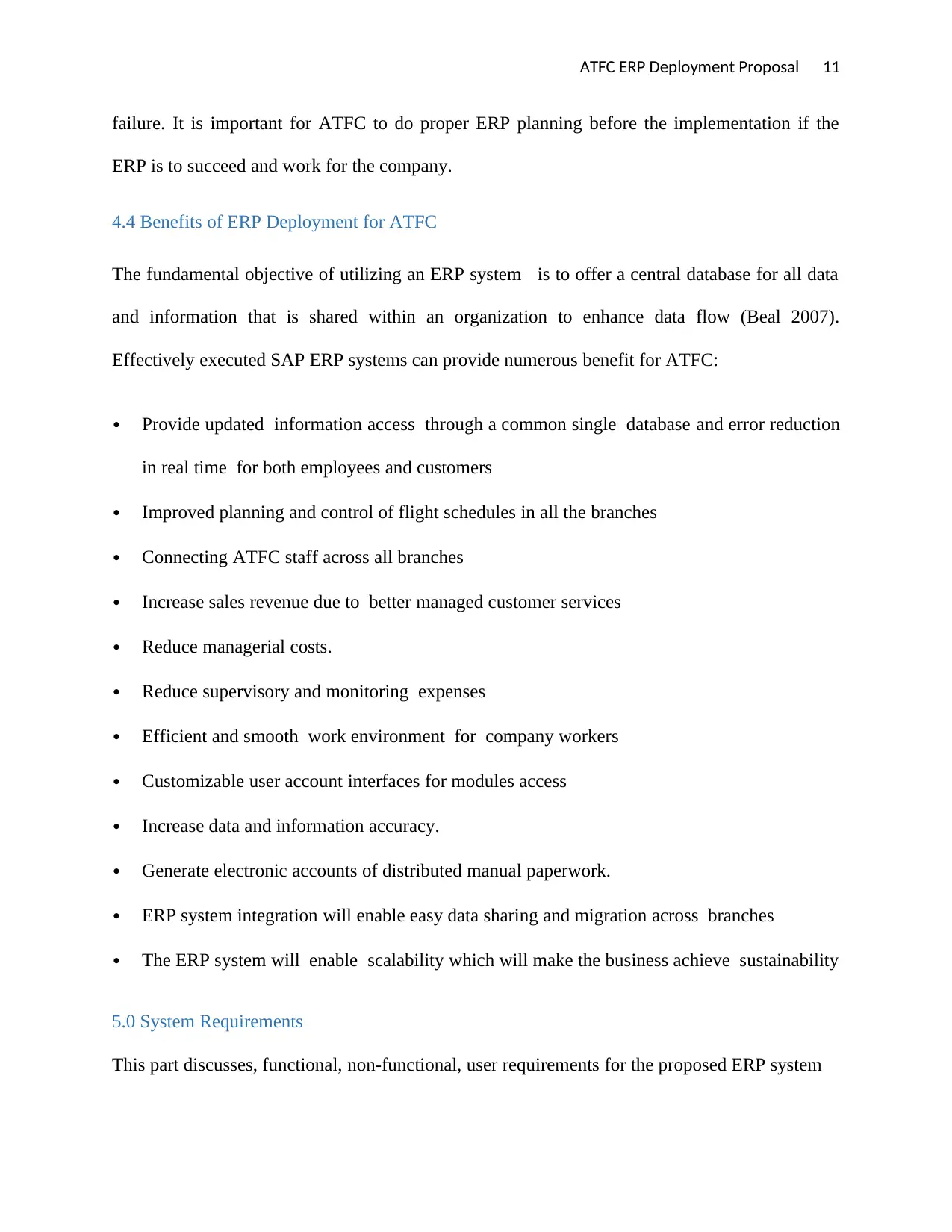
ATFC ERP Deployment Proposal 11
failure. It is important for ATFC to do proper ERP planning before the implementation if the
ERP is to succeed and work for the company.
4.4 Benefits of ERP Deployment for ATFC
The fundamental objective of utilizing an ERP system is to offer a central database for all data
and information that is shared within an organization to enhance data flow (Beal 2007).
Effectively executed SAP ERP systems can provide numerous benefit for ATFC:
Provide updated information access through a common single database and error reduction
in real time for both employees and customers
Improved planning and control of flight schedules in all the branches
Connecting ATFC staff across all branches
Increase sales revenue due to better managed customer services
Reduce managerial costs.
Reduce supervisory and monitoring expenses
Efficient and smooth work environment for company workers
Customizable user account interfaces for modules access
Increase data and information accuracy.
Generate electronic accounts of distributed manual paperwork.
ERP system integration will enable easy data sharing and migration across branches
The ERP system will enable scalability which will make the business achieve sustainability
5.0 System Requirements
This part discusses, functional, non-functional, user requirements for the proposed ERP system
failure. It is important for ATFC to do proper ERP planning before the implementation if the
ERP is to succeed and work for the company.
4.4 Benefits of ERP Deployment for ATFC
The fundamental objective of utilizing an ERP system is to offer a central database for all data
and information that is shared within an organization to enhance data flow (Beal 2007).
Effectively executed SAP ERP systems can provide numerous benefit for ATFC:
Provide updated information access through a common single database and error reduction
in real time for both employees and customers
Improved planning and control of flight schedules in all the branches
Connecting ATFC staff across all branches
Increase sales revenue due to better managed customer services
Reduce managerial costs.
Reduce supervisory and monitoring expenses
Efficient and smooth work environment for company workers
Customizable user account interfaces for modules access
Increase data and information accuracy.
Generate electronic accounts of distributed manual paperwork.
ERP system integration will enable easy data sharing and migration across branches
The ERP system will enable scalability which will make the business achieve sustainability
5.0 System Requirements
This part discusses, functional, non-functional, user requirements for the proposed ERP system
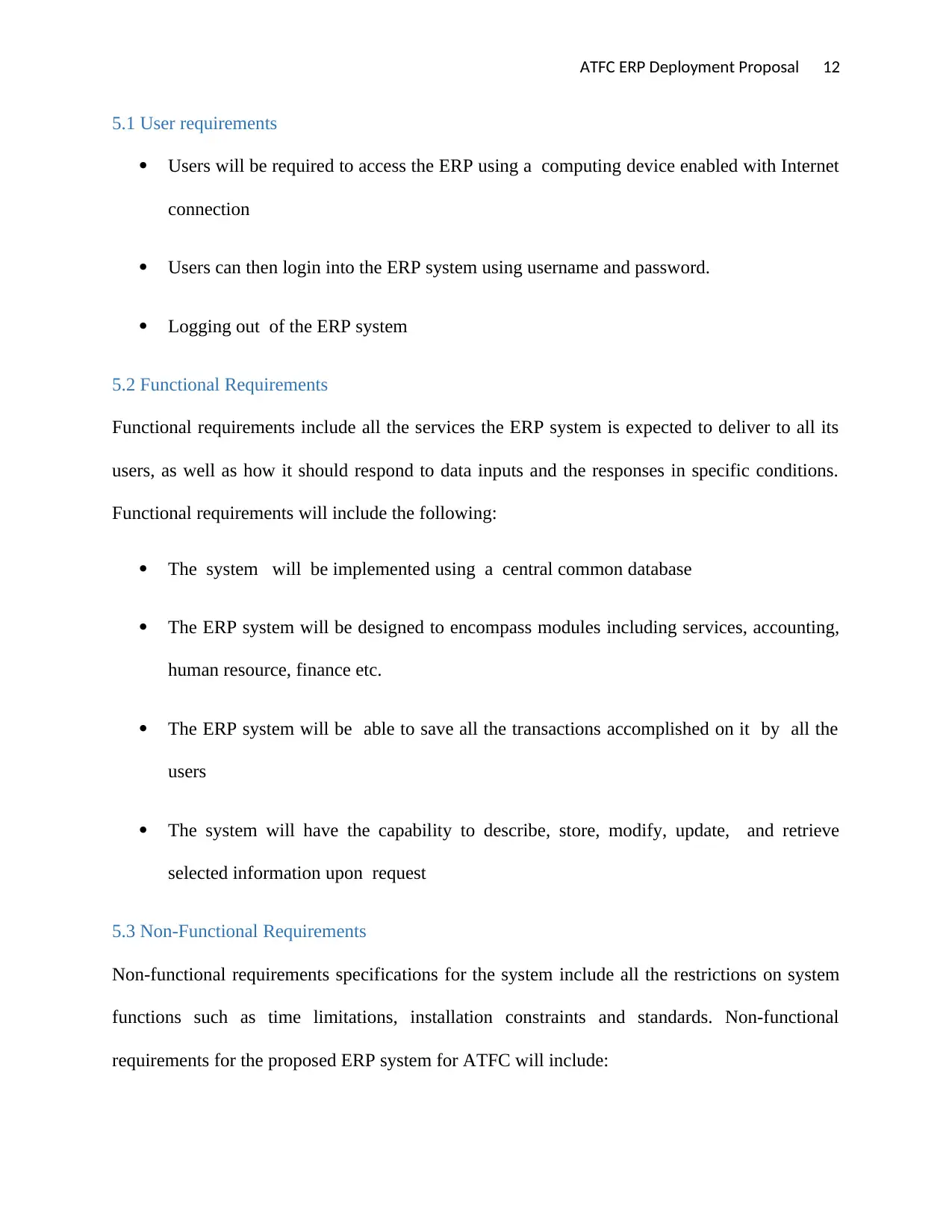
ATFC ERP Deployment Proposal 12
5.1 User requirements
Users will be required to access the ERP using a computing device enabled with Internet
connection
Users can then login into the ERP system using username and password.
Logging out of the ERP system
5.2 Functional Requirements
Functional requirements include all the services the ERP system is expected to deliver to all its
users, as well as how it should respond to data inputs and the responses in specific conditions.
Functional requirements will include the following:
The system will be implemented using a central common database
The ERP system will be designed to encompass modules including services, accounting,
human resource, finance etc.
The ERP system will be able to save all the transactions accomplished on it by all the
users
The system will have the capability to describe, store, modify, update, and retrieve
selected information upon request
5.3 Non-Functional Requirements
Non-functional requirements specifications for the system include all the restrictions on system
functions such as time limitations, installation constraints and standards. Non-functional
requirements for the proposed ERP system for ATFC will include:
5.1 User requirements
Users will be required to access the ERP using a computing device enabled with Internet
connection
Users can then login into the ERP system using username and password.
Logging out of the ERP system
5.2 Functional Requirements
Functional requirements include all the services the ERP system is expected to deliver to all its
users, as well as how it should respond to data inputs and the responses in specific conditions.
Functional requirements will include the following:
The system will be implemented using a central common database
The ERP system will be designed to encompass modules including services, accounting,
human resource, finance etc.
The ERP system will be able to save all the transactions accomplished on it by all the
users
The system will have the capability to describe, store, modify, update, and retrieve
selected information upon request
5.3 Non-Functional Requirements
Non-functional requirements specifications for the system include all the restrictions on system
functions such as time limitations, installation constraints and standards. Non-functional
requirements for the proposed ERP system for ATFC will include:
⊘ This is a preview!⊘
Do you want full access?
Subscribe today to unlock all pages.

Trusted by 1+ million students worldwide
1 out of 19
Related Documents
Your All-in-One AI-Powered Toolkit for Academic Success.
+13062052269
info@desklib.com
Available 24*7 on WhatsApp / Email
![[object Object]](/_next/static/media/star-bottom.7253800d.svg)
Unlock your academic potential
Copyright © 2020–2025 A2Z Services. All Rights Reserved. Developed and managed by ZUCOL.





